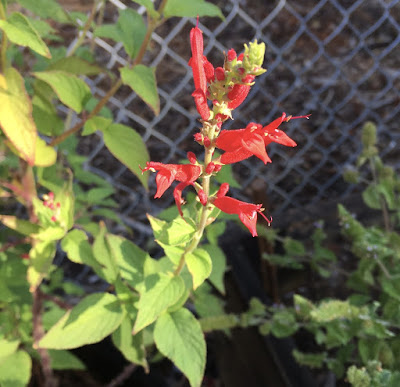
Thinking of bright and delicious blooms on a grey, soggy day

|
|
Pineapple sage (Salvia elegans) can do triple duty in the
garden. Its flowers entice pollinators, add bright beauty and are edible. The leaves also are edible. (Photo: Kathy Morrison) |
Well, we're definitely inside for a few days. It's cold and soggy outside, terrible gardening conditions. And wet soil shouldn't be walked on, anyway -- that compacts it, harming the soil structure and anything that is growing in that soil. And when compacted soil dries, it's more likely to be hard -- and harder to dig.
So, stuck indoors, the gardener can turn to catalogs, gardening guides, magazines, books and online publications that may have been stacking up (ahem!) or bookmarked for further reading. It's the best time all year to tackle that pile.
The Sacramento County master gardeners have dozens of online guides , so I dove into several I'd been meaning to get to. My current favorite, because it sounds so cheerful, is GN 155, Growing Edible Flowers in Your Garden.
I first saw flowers used in food when I was in college, visiting a friend in Oregon. One of her roommates crumbled a couple of marigold blooms into the salad. I was surprised -- this was long before organic gardening was common -- then intrigued. Turns out there are dozens of edible flowers, many of them quite familiar as ornamentals. This means much of the garden can incorporate double- or triple-duty plants: for beauty, food for humans, and food for pollinators and beneficial insects.
It's important to note that any pesticide-treated flower should NOT be eaten. This especially includes systemics, such as those sometimes used on roses.
But growing your own edible flowers means you can be sure they are free from pesticide residue.
While planning the spring garden, consider including some of the flowers listed here. Many more are listed on the aforementioned GN 155, which also notes specific flowers NOT to the eat.
Some pretty and edible flowers
Annuals: Borage (blue petals only); calendula (petals only), nasturtium, petunias, pineapple sage (often a perennial in our climate), radishes, scented geraniums (also a potential perennial; frost-sensitive), signet marigolds, snapdragons, violas.
Perennials: Bee balm, daylily, dianthus, hollyhocks, red clover.
Trees and shrubs: Apple, hibiscus, lilac, rose petals and rose hips, rosemary.
Comments
0 comments have been posted.Sacramento Digs Gardening to your inbox.
Food in My Back Yard Series
May 6: Maintain soil moisture with mulch for garden success
April 29: What's (already) wrong with my tomato plants?
April 22: Should you stock up on fertilizer? (Yes!)
April 15: Grow culinary herbs in containers
April 8: When to plant summer vegetables
April 1: Don't be fooled by these garden myths
March 25: Fertilizer tips: How to 'feed' your vegetables for healthy growth
March 18: Time to give vegetable seedlings some more space
March 11: Ways to win the fight against weeds
March 4: Potatoes from the garden
Feb. 25: Plant a fruit tree now -- for later
Feb. 18: How to squeeze more food into less space
Feb. 11: When to plant? Consider staggering your transplants
Feb. 4: Starting in seed starting
Sites We Like
Garden Checklist for week of May 4
Enjoy this spring weather – and get gardening!
* Plant, plant, plant! It’s prime planting season in the Sacramento area. Time to set out those tomato transplants along with peppers and eggplants. Pinch off any flowers on new transplants to make them concentrate on establishing roots instead of setting premature fruit.
* Direct-seed melons, cucumbers, summer squash, corn, radishes, pumpkins and annual herbs such as basil.
* Harvest cabbage, lettuce, peas and green onions.
* In the flower garden, direct-seed sunflowers, cosmos, salvia, zinnias, marigolds, celosia and asters. (You also can transplant seedlings for many of the same flowers.)
* Plant dahlia tubers. Other perennials to set out include verbena, coreopsis, coneflower and astilbe.
* Transplant petunias, marigolds and perennial flowers such as astilbe, columbine, coneflowers, coreopsis, dahlias, rudbeckia and verbena.
* Keep an eye out for slugs, snails, earwigs and aphids that want to dine on tender new growth.
* Feed summer bloomers with a balanced fertilizer.
* For continued bloom, cut off spent flowers on roses as well as other flowering plants.
* Add mulch to the garden to maintain moisture. Mulch also cuts down on weeds. But don’t let it mound around the stems or trunks of trees or shrubs. Leave about a 6-inch to 1-foot circle to avoid crown rot or other problems.